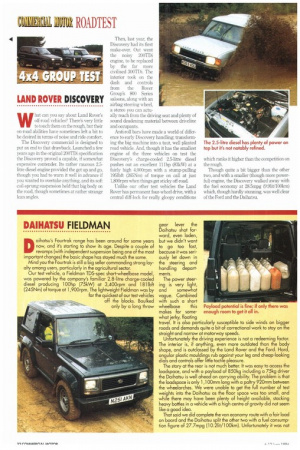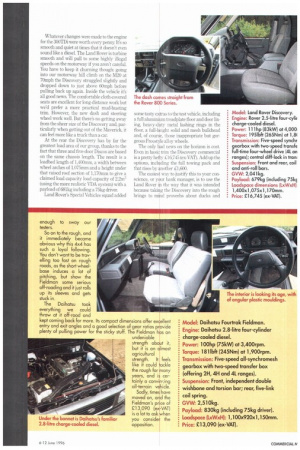LAND ROVER DISCOVERY
Page 36

Page 37

Page 38

If you've noticed an error in this article please click here to report it so we can fix it.
What can you say about Land Rover's off-road vehicles? There's very little to touch them on the rough, but their on-road abilities have sometimes left a bit to be desired in terms of noise and ride comfort.
The Discovery commercial is designed to put an end to that drawback. Launched a few years ago in the original 200TDi specification the Discovery proved a capable, if somewhat expensive contender. Its rather raucous aslitre diesel engine provided the get up and go, though you had to warn it well in advance if you wanted to overtake anything, and its soft coil-sprung suspension held that big body on the road, though sometimes at rather strange lean angles. Then, last year, the Discovery had its first make-over. Out went the noisy 200TD1 engine, to be replaced by the far more civilised 300TDi. The interior took on the dash and controls from the Rover Group's 800 Series saloons, along with an airbag steering wheel, a stereo you can actually reach from the driving seat and plenty of sound deadening material between driveline and occupants.
Anti-roll bars have made a world of difference to early Discovery handling; transforming the big machine into a taut, well planted road vehicle. And, though it has the smallest engine of the three vehicles on test the Discovery's charge-cooled 2.5-litre diesel pushes out an excellent 111hp (83kW) at a fairly high 4,000rpm with a stump-pulling 195Ibft (265Nm) of torque on call at just 1,800rpm when things get sticky off-road.
Unlike our other test vehicles the Land Rover has permanent four-wheel drive, with a central diff-lock for really gloopy conditions which ranks it higher than the competition on the rough.
Though quite a bit bigger than the other two, and with a smaller (though more powerful) engine, the Discovery walked away with the fuel economy at 28.5inpg (9.91it/100km) which, though hardly stunning, was well clear of the Ford and the Daihatsu. Whatever changes were made to the engine for the 300TDi were worth every penny. It's so smooth and quiet at times that it doesn't even sound like a diesel. The Land Rover is turbine smooth and will pull to some highly illegal speeds on the motorway if you aren't careful. You have to keep it churning though: going into our motorway hill climb on the M20 at 70mph the Discovery struggled slightly and dropped down to just above 60mph before pulling back up again. Inside the vehicle its all good news. The comfortable cloth-covered seats are excellent for long-distance work but we'd prefer a more practical mud-busting trim. However, the new dash and steering wheel work well. But there's no getting away from the sheer size of the Discovery and, particularly when getting out of the Maverick, it can feel more like a truck than a can
At the rear the Discovery has by far the greatest load area of our group, thanks to the fact that three and five-door Discos are based on the same chassis length. The result is a loadbed length of 1,400mm, a width between wheel arches of 1,075mm and a height under that raised roof section of 1,170mm to give a claimed load capacity load capacity of 22m3 (using the more realistic VDA system) with a payload of 681kg including a 75kg driver.
Land Rover's Special Vehicles squad added some tasty extras to the test vehicle, including a full aluminium treadplate floor and door lining. heavy-duty metal lashing rings in the floor, a full-height solid and mesh bulkhead and, of course, those inappropriate but gorgeous Freestyle alloy wheels.
The only bad news on the horizon is cost. Even in basic trim the Discovery commercial is a pretty hefty £16,745 (ex-VAT). Add up the options, including the full towing pack and that rises by another £1,600.
The easiest way to justify this to your conscience, or your bank manager, is to use the Land Rover in the way that it was intended because taking the Discovery into the rough brings to mind proverbs about ducks and water, That long-travel coil suspension just soaks up the bumps at speed on a rough track, as well as providing unrivalled articulation across deep ruts and holes. The only offroad problem we had was caused by the tow-bar mounting plate, which is low enough to drastically reduce exit angles on steep This van had a gear for everything, with an ultra-low first in the bottom box for really steep descents. The all-round disc brakes provided plenty of stopping power in even the wettest conditions.






















































































































